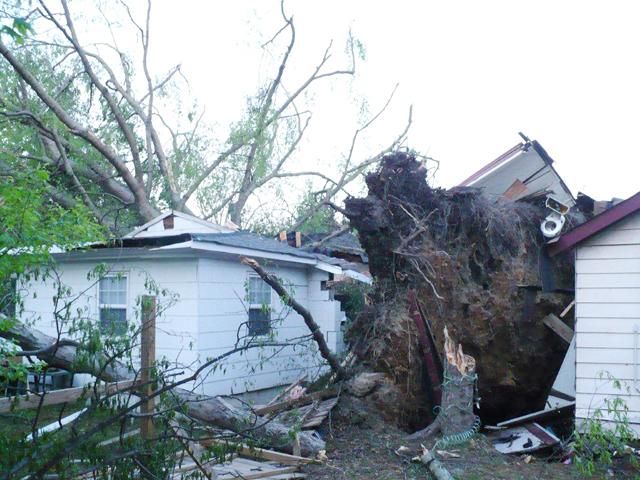As tornadoes cut a wide swath of damage in the area, the National Weather Service gave local and national weather reports, updating the public with video surveillance and preemptive safety measures for those unable to leave the area.
Two students and one alumnus, all with significant meteorological backgrounds, aided the investigation with first-hand accounts of their storm chasing adventure.
“Our first target storm was the supercell approaching Raleigh. We observed bright power flashes from our position on the beltline,” said Kevin Smith, senior in meteorology, who explained the first storm the group followed.
“Transformers were exploding under the tornado. There were too many trees in the way and the tornado was rain-wrapped, so we were not able to get a clear visual,” said Smith.
The three then changed course to follow a second supercell to the south, approaching the Wilson region. Here, the tornado was within eyesight, and they witnessed a scene any storm chaser would like to see,
“We watched a large tornado cross Interstate 795 just one or two miles ahead of us. Nothing I had ever seen in the field even remotely compared to the tornado that crossed the road ahead of us near Wilson,” said Smith, who had participated in the VORTEX2 Project, a scientific field project to further analyze and understand tornadoes.
“Several words come to mind: nerve-racking, exhilarating, and at the same time humbling to see the damage,” said Todd Ferebee, a senior in meteorology.
Ferebee goes on to warn prospective storm chasers against heading into the path of a tornado: “I would not recommend anyone to try this if they don’t have some knowledge about storm chasing and meteorology in general, because you can die very easily if you do not know what you are doing,” he said.
”Storm chasing can be an extremely dangerous activity if you do not know what you are doing. We’ve been through SKYWARN Spotter classes, and had years of experience learning about meteorology and how storms behave. Without this type of knowledge, you shouldn’t be out in the field during severe weather outbreaks,” said North Carolina State University alumni Jeremy Gilchrist, also recognizing the danger involved.
During their eyewitness accounts, Smith, Ferebee, and Gilchrist contacted the National Weather Service to give their accounts of their observations via radio through Central Carolina SKYWARN, according to Smith.
When asked the motive behind his endeavor, Smith said, “I am absolutely fascinated by the weather, particularly severe storms. Seeing one of the most destructive phenomena Mother Nature can throw at us is exhilarating to say the least.”
Meteorologists studying the field of severe or extreme weather also assume responsibility as public servants, dedicated to informing and protecting the public. Armed with NOAA Weather Radio, radar and a GPS, three young meteorologists put their lives on the line as dedication to their field of study, Smith said.
“As a SKYWARN Spotter, I am the ‘eyes and ears’ on the ground for the National Weather Service, and I want to help get reports to them so they have a better idea of exactly what is happening and can warn the public,” Smith said.
Furthermore, Smith works as an Emergency Net Control Operator for Central Carolina SKYWARN. He helps to run amateur radio nets by collecting damage reports from spotters in the field for the National Weather Service.
Todd closes with an affirmation of his interest in studying what most consider to be a violent, harsh and unpredictable field.
“Yes, it is an unsafe business. But, again, if you do not know what you are doing, you do not belong out in the field,” Todd said. “You could very well lose your life on a day like this past Saturday.”








